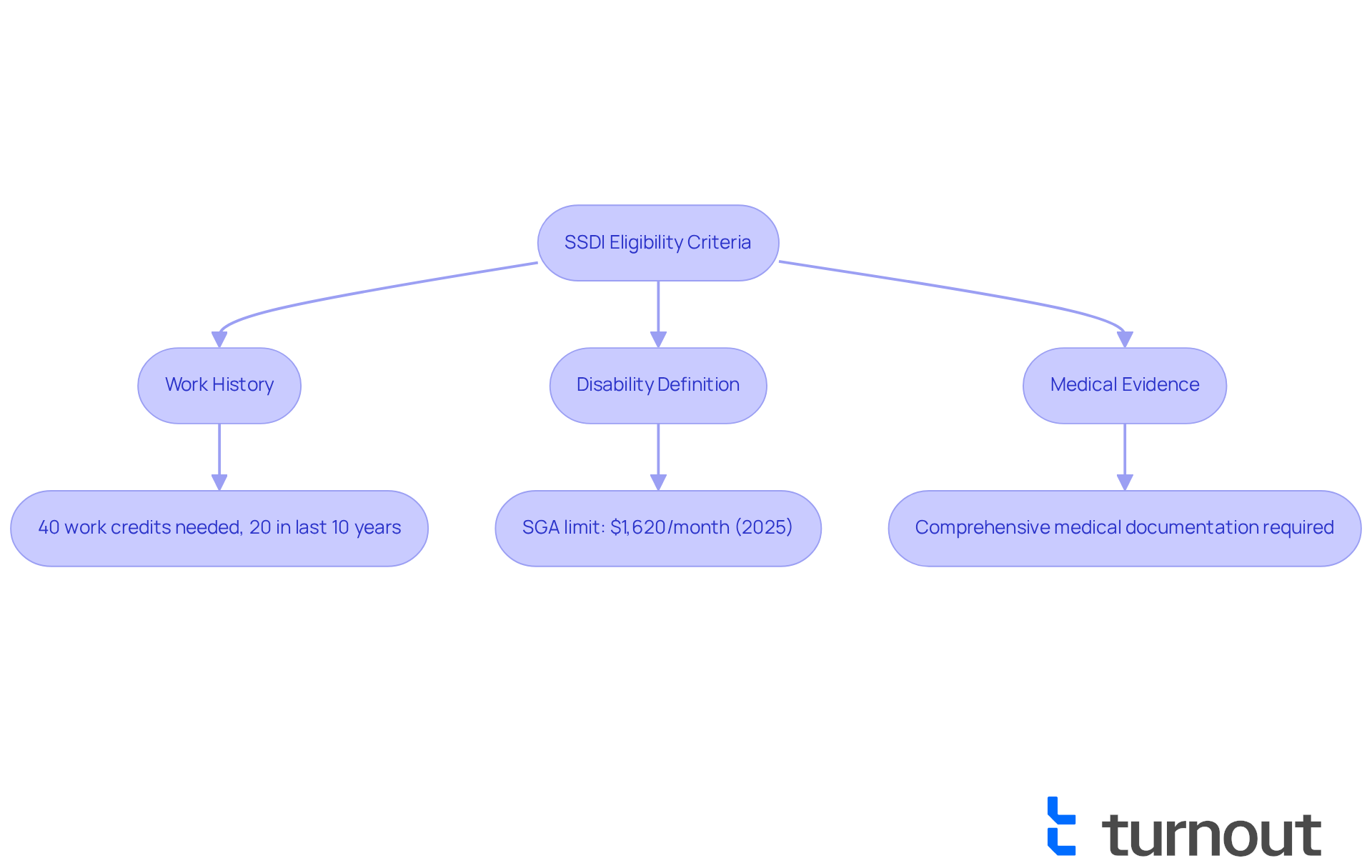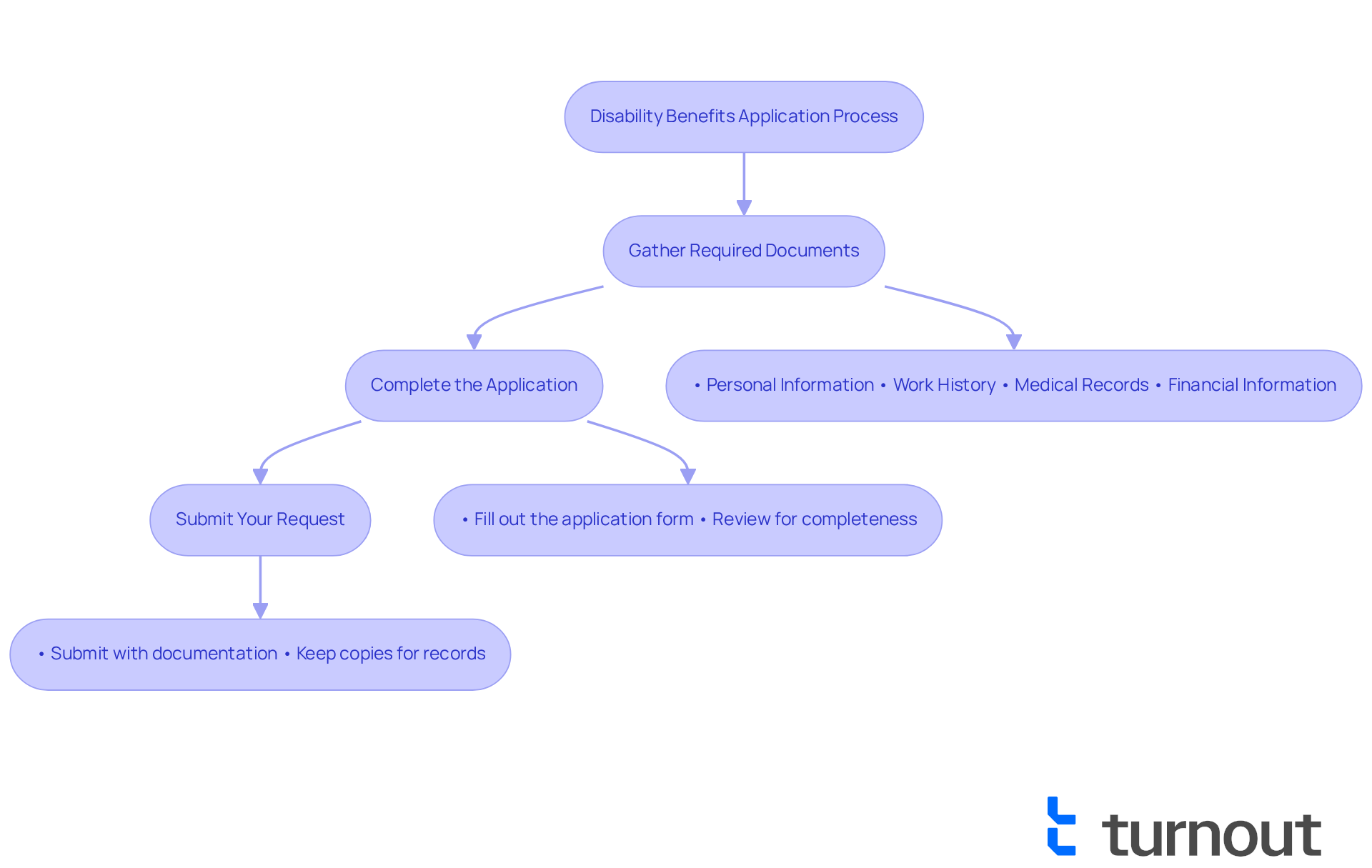Overview
Navigating the process of securing Social Security Disability Insurance (SSDI) benefits can feel overwhelming. We understand that many individuals face significant challenges during this journey. It's essential to grasp the eligibility criteria, gather the necessary documentation, and be aware of common hurdles that may arise.
To help you through this process, we outline key steps that can make a difference:
- Understand specific application requirements, such as your work history and medical evidence.
- Thorough preparation is vital.
- Seek support from advocates, which can significantly enhance your chances of approval.
Remember, you are not alone in this journey. Many have faced similar struggles and found success with the right support and information. We encourage you to take these steps with confidence, knowing that thorough preparation and understanding can lead to a more favorable outcome. We're here to help you every step of the way.
Introduction
Navigating the complexities of Social Security Disability Insurance (SSDI) can feel overwhelming, especially for those facing the challenges of a qualifying disability. We understand that the process is fraught with uncertainty. It’s crucial to grasp the eligibility criteria, required documentation, and common pitfalls that could hinder your journey toward these vital benefits.
With over 60 percent of initial applications denied, the stakes are indeed high. What steps can you take to not only secure your SSDI benefits but also prepare for the potential hurdles ahead? You're not alone in this journey, and we're here to help.
Understand SSDI: Key Concepts and Eligibility Criteria
Social Security Disability Insurance (SSDI) is a federal initiative designed to provide financial support to individuals who are unable to work due to a qualifying disability. We understand that navigating this process can be overwhelming, so it's essential to know the eligibility criteria:
-
Work History: To qualify, applicants must have worked in jobs covered by Social Security and earned enough work credits—typically at least 40 credits, with 20 earned in the last 10 years. This requirement ensures that individuals have contributed to the system before seeking benefits.
-
Disability Definition: The Social Security Administration (SSA) defines disability as the inability to engage in substantial gainful activity (SGA) due to a medically determinable physical or mental impairment expected to last at least 12 months or result in death. For 2025, the SGA limit for non-blind individuals is set at $1,620 per month. Understanding this financial threshold is crucial for applicants.
-
Medical Evidence: It's vital for applicants to provide comprehensive medical documentation that supports their claim. This includes detailed diagnoses, treatment history, and descriptions of how the disability impacts daily life.
Please note that Turnout is not a law firm and does not provide legal advice. Our trained nonprofessional advocates are here to help with SSDI by assisting you in preparing your submission and understanding the requirements, without offering legal representation. Grasping these fundamental concepts is key to successfully navigating the disability benefits application process. Familiarizing yourself with the eligibility criteria will empower you to assess your situation and prepare for the next steps.
As Kathleen Romig notes, "Most rejected applicants under the new standard will have very significant medical impairments, and many will struggle to access health care without those benefits." This highlights the importance of being thoroughly prepared when seeking disability benefits, especially considering potential changes to eligibility requirements that could affect many applicants. Remember, you are not alone in this journey—we're here to help you every step of the way.

Gather Required Documentation and Complete the Application Process
Applying for disability benefits can feel overwhelming, but there are resources available to help with SSDI, and you're not alone in this journey. To help you navigate the process with confidence, it’s essential to gather specific documentation and follow these steps:
-
Identify Required Documents: Collect the following:
- Personal Information: Your Social Security number, birth certificate, and contact information are crucial.
- Work History: Detail your employment for the past 15 years, including job titles, duties, and employer information.
- Medical Records: Obtain records from your healthcare providers, including diagnoses, treatment plans, and any relevant test results.
- Financial Information: Document your income, assets, and any other benefits you receive.
-
Complete the Application: You can apply for SSDI online, by phone, or in person at your local Social Security office. Remember to:
- Fill out the application form accurately, providing all requested information.
- Review your submission for completeness before sending it off.
-
Submit Your Request: Once your request is complete, submit it along with all gathered documentation. Keep copies of everything for your records.
We understand that the initial review process for SSDI requests can take 3-5 months, so thorough preparation can help with SSDI. Organizing your personal, medical, and employment details can significantly enhance your chances of a successful submission. In fact, over 60 percent of initial disability benefits requests were denied in 2024, underscoring the importance of a well-prepared application.
Real-life examples show that candidates who carefully organize their paperwork and follow submission procedures often experience more efficient processing times and improved approval rates. By following these guidelines, you can create a comprehensive and well-organized disability benefits request that will help with SSDI approval. Remember, we’re here to help you every step of the way.

Navigate Common Challenges and Troubleshoot Application Issues
Even with thorough preparation, we understand that applicants may need help with SSDI as they encounter challenges during the submission process. It's common to feel overwhelmed, but knowing the common issues and strategies to troubleshoot them can make a difference:
-
Request Denials: If your request is denied, carefully review the denial letter to understand the reasons. Common issues include insufficient medical evidence or failure to meet work history requirements. Remember, you can appeal the decision by filing a request for reconsideration within 60 days. Many claims are overturned at this stage, so don’t lose hope.
-
Delayed Processing: SSDI requests can take time to process, with over 1 million claims pending as of January 2025. If you encounter delays, reach out to the Social Security Administration to verify the status of your request. Keeping a record of all communications can be beneficial in tracking your case.
-
Insufficient Health Evidence: If the SSA requests additional health documentation, respond promptly. Collaborate with your healthcare providers to ensure they supply the necessary information to support your claim. Many requests are rejected due to insufficient medical evidence, making a robust medical file essential.
-
Confusion Over Requirements: If you are unsure about any aspect of the submission procedure, consider contacting Turnout's trained nonlegal advocates for tailored assistance. They can help clarify requirements and assist with documentation, significantly increasing your chances of approval. It's important to note that Turnout is not a law firm and does not provide legal advice. However, individuals with representation are four times more likely to receive benefits compared to those without. As one representative noted, "Having experienced support can greatly enhance your likelihood of success."
By being aware of these challenges and knowing how to address them, you can navigate the SSDI application process more effectively. Remember, you are not alone in this journey. Having experienced support from Turnout can greatly enhance your likelihood of success, as individuals with representation are four times more likely to receive benefits compared to those without.

Conclusion
Securing Social Security Disability Insurance (SSDI) benefits is a crucial lifeline for those unable to work due to qualifying disabilities. We understand that navigating this process can be overwhelming. By familiarizing yourself with the eligibility criteria, gathering necessary documentation, and understanding the application process, you can significantly improve your chances of success. Remember, you are not alone in this journey.
This article has outlined the key components of the SSDI application process. It emphasized the importance of your work history, the definition of disability, and the need for comprehensive medical evidence. Meticulous documentation is vital, and we provided practical steps to help you complete your application effectively. It’s common to face challenges, such as requests for denials or insufficient health evidence. However, we offered strategies to troubleshoot these issues.
Ultimately, taking proactive measures and seeking assistance can greatly enhance your likelihood of a successful SSDI claim. It’s essential to remember that support is available. Utilizing resources like nonlegal advocates can make a substantial difference in navigating the application process. By being informed and prepared, you can empower yourself to secure the benefits you need and deserve. We're here to help you every step of the way.
Frequently Asked Questions
What is Social Security Disability Insurance (SSDI)?
SSDI is a federal initiative that provides financial support to individuals who are unable to work due to a qualifying disability.
What are the eligibility criteria for SSDI?
To qualify for SSDI, applicants must have worked in jobs covered by Social Security, earning at least 40 work credits, with 20 of those earned in the last 10 years. Additionally, they must meet the definition of disability set by the Social Security Administration (SSA).
How does the SSA define disability?
The SSA defines disability as the inability to engage in substantial gainful activity (SGA) due to a medically determinable physical or mental impairment expected to last at least 12 months or result in death.
What is the SGA limit for non-blind individuals in 2025?
The SGA limit for non-blind individuals in 2025 is set at $1,620 per month.
What type of medical evidence is required for an SSDI application?
Applicants must provide comprehensive medical documentation, including detailed diagnoses, treatment history, and descriptions of how the disability impacts their daily life.
Can Turnout provide legal advice for SSDI applications?
No, Turnout is not a law firm and does not provide legal advice. They offer assistance in preparing submissions and understanding requirements through trained nonprofessional advocates.
Why is it important to be prepared when applying for SSDI?
Being thoroughly prepared is crucial as many rejected applicants have significant medical impairments and may struggle to access healthcare without benefits. Familiarizing oneself with eligibility criteria can empower applicants to assess their situation and prepare for the next steps.




